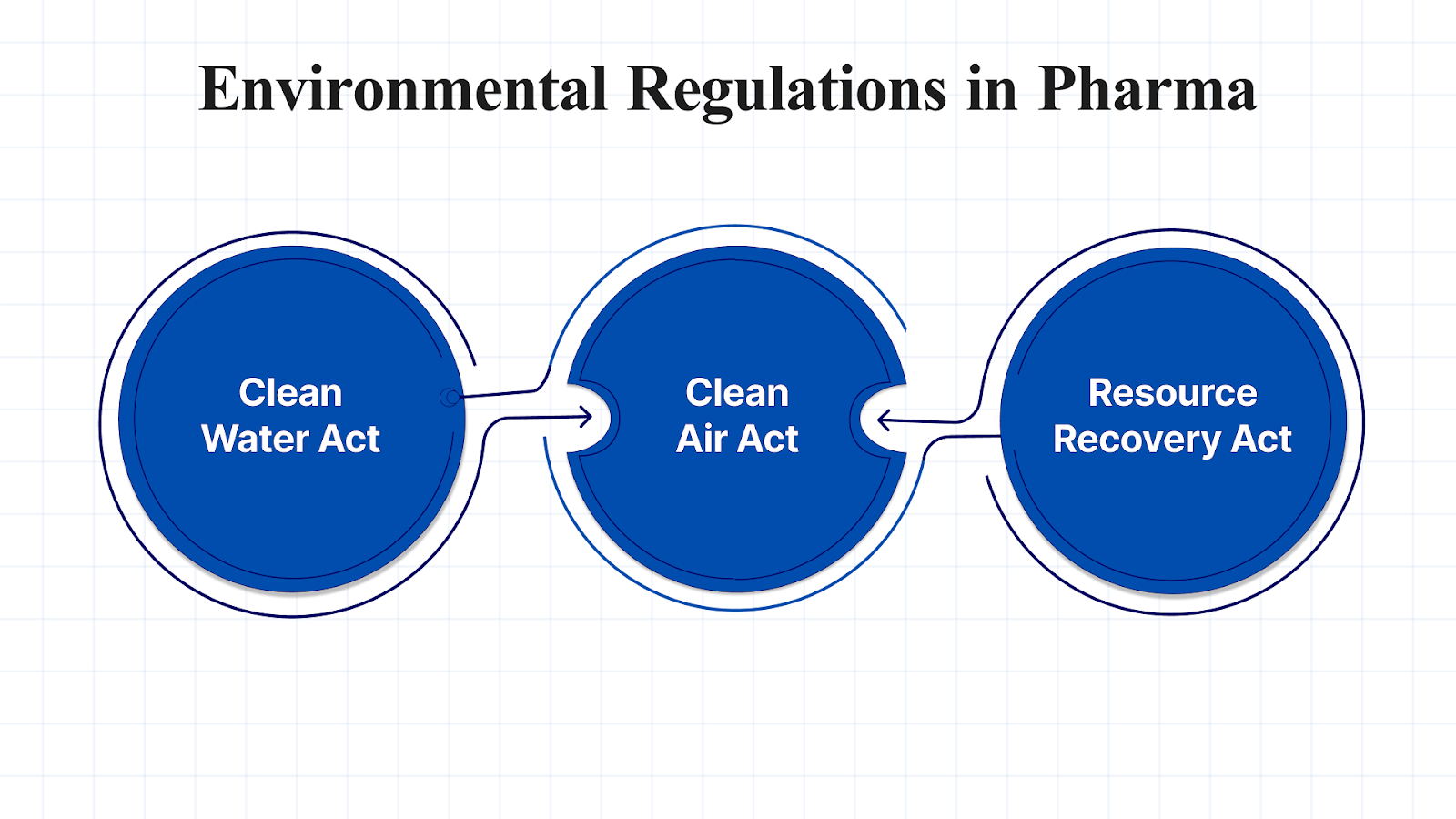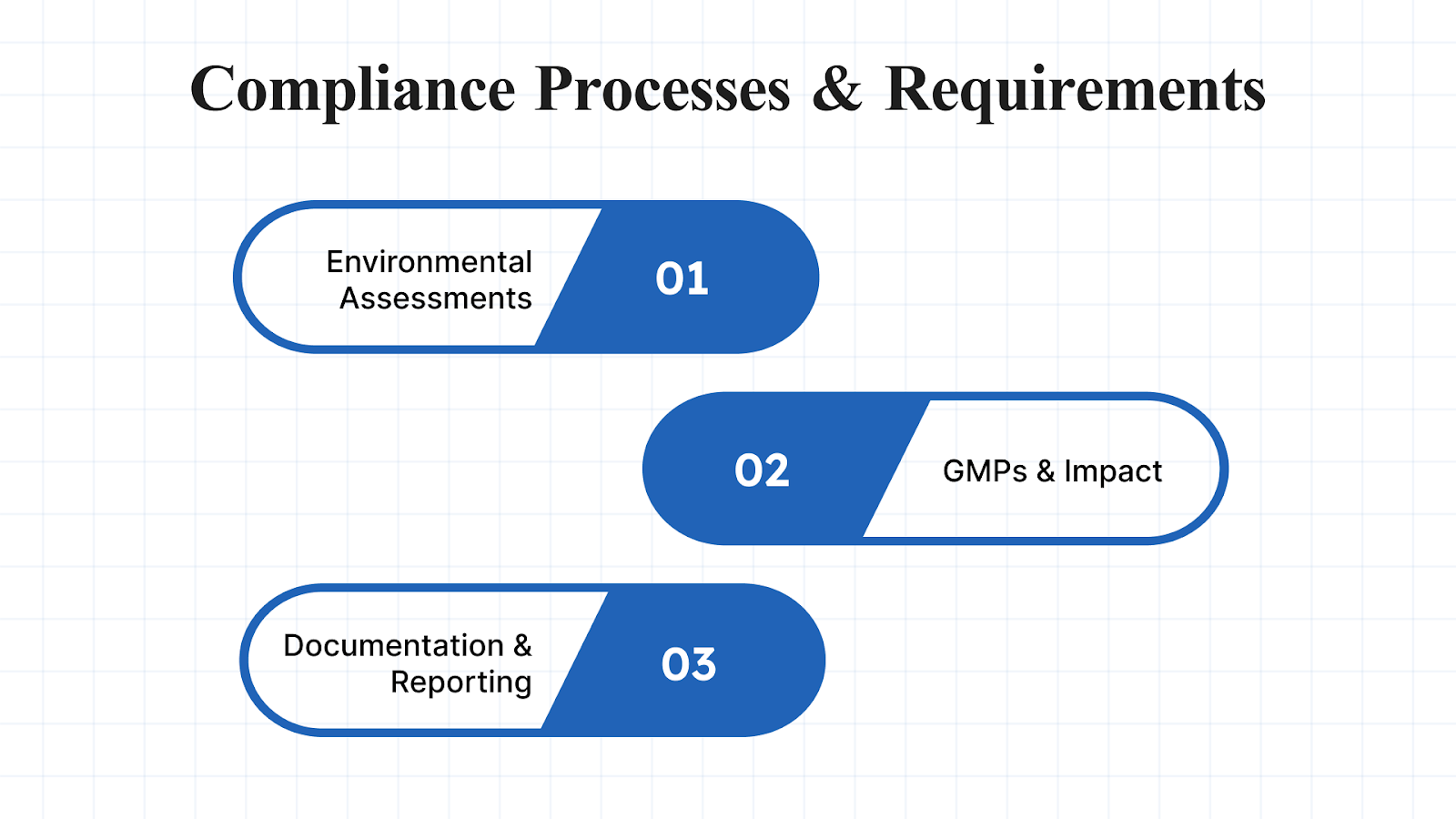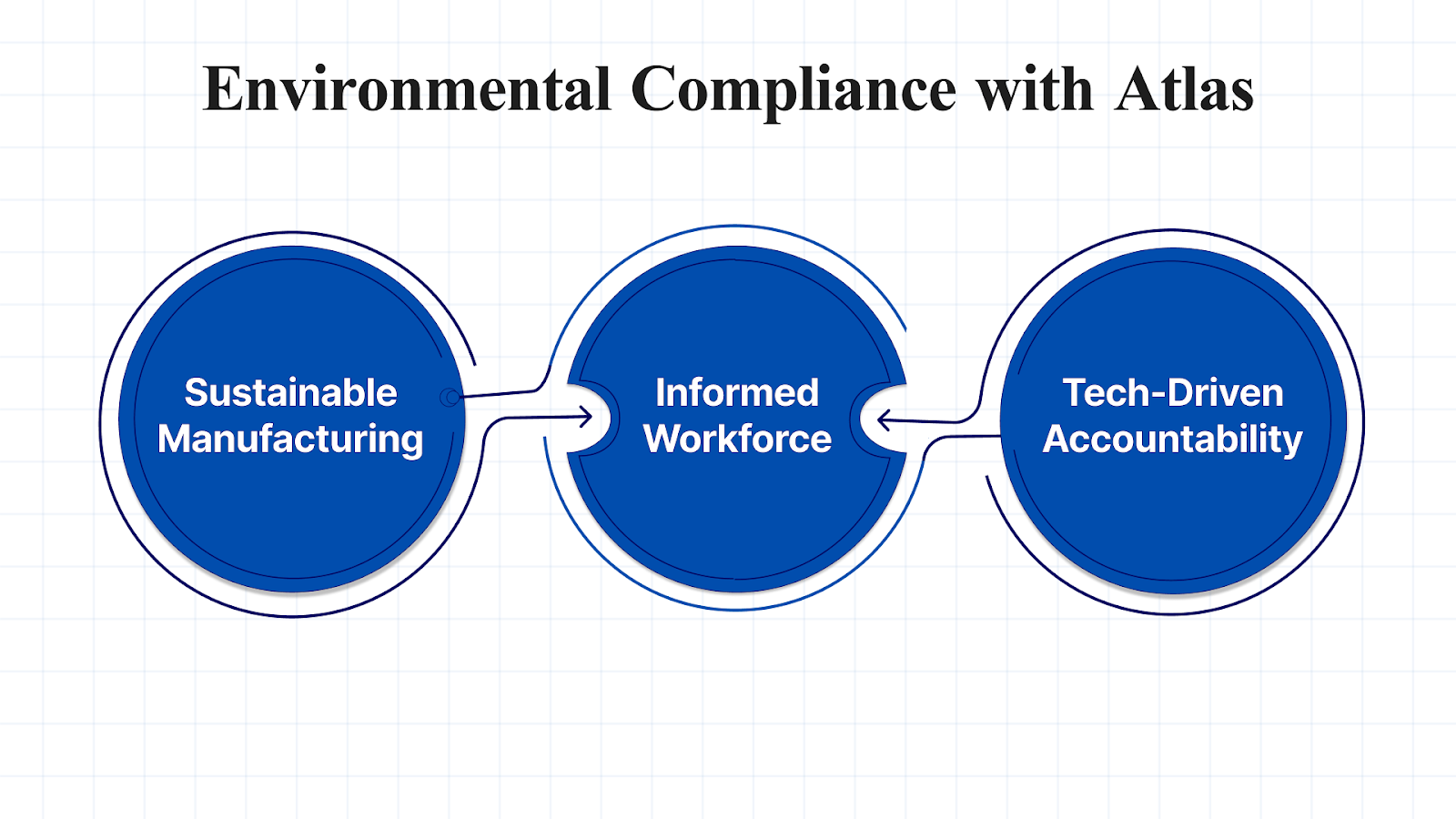In an industry known for medical innovation, the pharmaceutical sector also faces growing scrutiny over its environmental impact and compliance responsibilities. While drug safety dominates headlines, environmental regulatory compliance is becoming just as crucial for long-term operations and corporate responsibility.
The industry emits nearly 52 megatons of CO₂ annually, equivalent to the pollution from 11 million cars, making its environmental footprint impossible to ignore. In response, major companies have increased green spending to $5.2 billion in 2025, a 300% rise since 2020, to meet compliance standards.
With the FDA tightening its environmental oversight, pharmaceutical firms must align with evolving laws or risk penalties, license issues, and reputational harm.
This blog explores the key regulations, compliance strategies, FDA expectations, and best practices in environmental regulatory compliance for the pharmaceutical industry.
What is Environmental Regulatory Compliance in Pharmaceuticals?
Pharmaceutical manufacturing involves intricate chemical processes, heavy water usage, and the production of multiple waste streams, all of which create significant environmental pressure points. These operations naturally fall under close environmental scrutiny.
Why Compliance Matters?
Environmental compliance goes beyond ticking off legal requirements; it’s about how seriously a company treats its environmental impact. Staying aligned with expectations builds trust with regulators, the public, and investors. It also helps avoid costly waste issues or operational disruptions. Failing to comply can result in production delays, costly penalties, and long-term damage to a company’s reputation in the market.
Environmental Compliance Within the Regulatory Framework
Compliance with environmental standards doesn’t exist in isolation. It’s tied to broader regulatory expectations that govern the development, production, and distribution of pharmaceuticals. Following environmental rules is a sign that a company understands how to operate responsibly within the legal and ethical framework set by national and global authorities.
Although the FDA’s central role revolves around public health, its oversight often intersects with environmental concerns, especially when it comes to manufacturing sites and process design. The intent is clear: drug production should not threaten ecosystems or public health through indirect exposure routes like water or air contamination. Environmental responsibility, therefore, becomes a vital extension of product safety.
What are the Key Environmental Regulations Impacting Pharmaceuticals?

Pharmaceutical manufacturing doesn’t just require precision in formulation; it also involves close attention to how operations affect the environment. In the U.S., environmental compliance for pharma companies is shaped by major federal laws like the Clean Water Act, Clean Air Act, and Resource Conservation and Recovery Act (RCRA). These laws are often complemented by state and local rules, making compliance a multi-jurisdictional task that requires careful oversight. Here are some of the most prominent:
1. Clean Water Act (CWA):
The Clean Water Act regulates how pollutants are released into surface waters. For pharmaceutical facilities, wastewater streams may contain active pharmaceutical ingredients (APIs), solvents, and other process-related chemicals. Compliance typically involves securing discharge permits like those under the National Pollutant Discharge Elimination System (NPDES) and setting up systems to treat and monitor water quality before discharge.
2. Clean Air Act (CAA):
This law governs air emissions from industrial activities, including those from drug manufacturing. Many pharmaceutical operations use organic solvents that emit volatile organic compounds (VOCs), as well as generate fine particles and other airborne pollutants. Meeting air quality requirements involves identifying emission points, securing air permits, installing control equipment, and conducting routine emissions tracking to stay within regulatory thresholds.
3. Resource Conservation and Recovery Act (RCRA):
RCRA sets the standards for managing hazardous waste throughout its lifecycle from generation to disposal. In pharmaceutical settings, this includes unused or expired drugs, contaminated lab supplies, chemical residues, and manufacturing by-products. Following RCRA means correctly classifying waste, labeling and storing it securely, maintaining proper documentation, and working with licensed disposal providers to avoid contamination and make sure of workplace safety.
Knowing the key environmental laws is just the foundation. In pharmaceuticals, the FDA also plays a critical part where production practices and environmental responsibilities overlap. Next, let’s look at how the FDA enforces environmental compliance and collaborates with other regulatory bodies.
FDA’s Role in Environmental Compliance
Although the Environmental Protection Agency (EPA) leads federal efforts on environmental protection, the FDA holds substantial influence over how pharmaceutical companies manage their environmental responsibilities, particularly through its Current Good Manufacturing Practices (CGMP) framework.
1. How do FDA Regulations Influence Environmental Practices?
While the FDA doesn’t create environmental law, its oversight of CGMP requirements directly affects how companies approach cleanliness, waste handling, and contamination control. These operational standards, such as maintaining sanitary facilities, validating cleaning protocols, and safely disposing of by-products, naturally support better environmental outcomes. Additionally, in some drug approval cases, the FDA may call for environmental assessments to review any possible ecological impact linked to the product or its manufacturing process.
2. How the FDA Enforces Environmental Aspects?
The FDA monitors compliance through site inspections, document reviews, and audits. Though it doesn’t enforce EPA regulations, it will examine whether environmental practices interfere with product quality or operational integrity. For instance, poor handling of hazardous waste might raise red flags during a GMP inspection and lead to citations, warning letters, or more serious corrective action.
3. How Does the FDA Work Alongside Other Agencies?
The FDA often collaborates with agencies like the EPA, particularly when environmental risks intersect with public health or product safety concerns. This shared oversight helps build a regulatory environment where safety, quality, and environmental responsibility are treated as interconnected priorities.
Understanding the FDA’s role sets the stage for what comes next. Pharmaceutical companies must adhere to specific processes and meet detailed requirements to remain aligned with environmental expectations. Let’s break down the key steps involved in maintaining compliance.
Key Processes and Requirements for Compliance

Staying compliant in the pharmaceutical space isn’t about one-time checks; it demands a structured and ongoing approach to both operations and documentation.
1. Environmental Assessment Practices
Before launching a new site or changing an existing process, companies typically perform environmental assessments. These help identify how operations might affect air, water, soil, or nearby ecosystems. The findings guide necessary control measures, such as emission limits or waste handling protocols, to reduce long-term impact.
2. GMPs with Environmental Relevance
Good Manufacturing Practices (GMPs) form the backbone of FDA oversight. They guide everything from facility hygiene to emissions management and waste handling. Environmental protection becomes part of the maintaining process integrity and operational control.
These GMP standards are codified under Title 21 of the Code of Federal Regulations (CFR), which outlines specific requirements for manufacturers:
- 21 CFR Part 210: GMPs for manufacturing, processing, packing, or holding of drugs
- 21 CFR Part 211: GMPs for finished pharmaceuticals
- 21 CFR Part 212: GMPs for Positron Emission Tomography (PET) drugs
- 21 CFR Part 314: Application requirements for new drug approvals
- 21 CFR Part 600: General requirements for biological products
Together, these sections help align expectations between manufacturers, FDA reviewers, and regulatory staff, building consistency in both product safety and environmental safeguards.
3. Required Documentation and Reporting
Compliance is built on records. Permits, emissions logs, waste disposal forms, spill reports, and staff training files all form part of the compliance package. Most records must be made available for inspection and reported periodically to relevant agencies, often serving as the basis for audits or licensing reviews.
While the processes are well-defined, implementing them isn’t always straightforward. Pharmaceutical companies frequently encounter practical challenges in achieving environmental compliance goals. Let’s look at some of the most common challenges.
Challenges in Achieving Compliance
Despite the clear imperative, pharmaceutical companies face significant challenges in achieving and maintaining environmental compliance.
- Technical and Logistical Challenges: The complexity of pharmaceutical manufacturing processes often makes it technically challenging to implement advanced environmental control technologies or eliminate specific waste streams. Logistical hurdles can arise in managing hazardous waste, particularly across international borders.
- Economic Impacts: Investing in state-of-the-art pollution control equipment, implementing new sustainable practices, and maintaining robust compliance programs can entail substantial financial outlays. This can be a significant burden, especially for smaller pharmaceutical companies.
- Navigating Complex Regulatory Environments: The sheer volume and intricate nature of environmental regulations, coupled with differing requirements across jurisdictions, can be daunting. Keeping abreast of evolving laws and interpreting their applicability requires specialized expertise.
Despite the challenges, many pharmaceutical companies are finding ways to adapt. Let’s look at practical strategies and how Atlas Compliance is helping drive real progress on the ground.
Practical Strategies for Environmental Compliance: Spotlight on Atlas Compliance

Meeting environmental obligations requires more than policy; it demands the right tools, systems, and mindset. Here’s how pharmaceutical companies are making it work on the ground.
1. Smarter Manufacturing with Sustainability in Focus
Companies are reevaluating their production methods to reduce emissions, minimize water usage, and manage waste more effectively.
How Atlas Compliance helps: It supports these shifts through tailored risk and compliance management frameworks that align with environmental benchmarks.
2. Technology That Drives Accountability
From automated monitoring systems to digital compliance tracking, technology is playing a bigger role in meeting environmental standards.
How Atlas Compliance helps: It offers platforms that simplify documentation, reporting, and real-time data access, making it easier to stay ahead of audits and regulatory changes.
3. Building an Informed Workforce
Regulations only work when teams understand them. Ongoing training is key.
How Atlas Compliance helps: It helps clients build internal awareness by integrating compliance guidelines into daily operations through intuitive systems and employee modules.
While current strategies are helping companies stay on track, the landscape isn’t standing still. Next, let’s explore what the future holds for environmental compliance in pharmaceuticals.
The Future of Environmental Compliance in Pharmaceuticals
Environmental compliance in the pharmaceutical industry is entering a period of change, shaped by global policy shifts, new technologies, and growing public expectations.
1. Shifting Regulatory Priorities
Upcoming regulations may tighten controls on pharmaceutical contaminants in wastewater and expand requirements for complete lifecycle assessments of products from raw material sourcing to disposal. There’s also growing interest in circular models that reduce waste and extend the value of materials used in production.
2. Evolving FDA Focus
The FDA is likely to increase its focus on environmental effects within current regulations. Upcoming guidelines might require more detailed environmental assessments during drug approvals or when new manufacturing processes are introduced.
3. Global Policies & Their Local Impact
Climate agreements and international sustainability goals are prompting countries to revisit their environmental laws. It could lead to more unified regulatory expectations across regions, posing both challenges and opportunities for pharmaceutical companies with global operations.
Conclusion
Environmental regulatory compliance in the pharmaceutical sector isn’t just about meeting FDA rules; it’s a core aspect of ethical, future-ready manufacturing. Companies that prioritize cleaner processes, invest in the right technologies, and promote environmental responsibility are better positioned to manage regulatory shifts and build lasting trust.
Atlas Compliance supports pharmaceutical firms with tools and expertise tailored to the industry’s environmental obligations. From documentation systems to audit readiness and integrated compliance workflows, Atlas helps simplify complexity without compromising standards.
The path forward requires consistency, clarity, and the right support systems. If you’re ready to strengthen your approach to environment regulatory compliance with pharmaceutical FDA standards, book a consultation with Atlas Compliance today and take the next step toward sustainable operations.
FAQs
Q1. What is environmental regulatory compliance in the pharmaceutical industry?
A. Environmental regulatory compliance in the pharmaceutical industry involves meeting legal standards for waste, emissions, and sustainability set by agencies such as the FDA and EPA.
Q2. How does the FDA influence environmental compliance in pharma?
A. The FDA influences environmental compliance through Good Manufacturing Practices (GMPs) and drug approval processes that may require environmental assessments.
Q3. Which laws govern environment regulatory compliance pharmaceutical FDA processes?
A. Key laws include the Clean Air Act, Clean Water Act, RCRA, and FDA regulations under 21 CFR Parts 210, 211, and 314, which govern the manufacturing and approval of drugs.
Q4. Why is environmental compliance important for pharmaceutical companies?
A. It reduces environmental harm, avoids penalties, ensures product safety, and helps companies align with FDA and EPA environmental expectations.
Q5. What role does GMP play in environmental compliance?
A. GMP guidelines under FDA oversight indirectly impact environmental compliance by requiring safe waste handling, facility hygiene, and process controls.
Q6. How can pharmaceutical firms improve environmental regulatory compliance?
A. They can adopt sustainable practices, utilize compliance software like Atlas, and stay updated on environmental regulatory compliance and pharmaceutical FDA requirements.